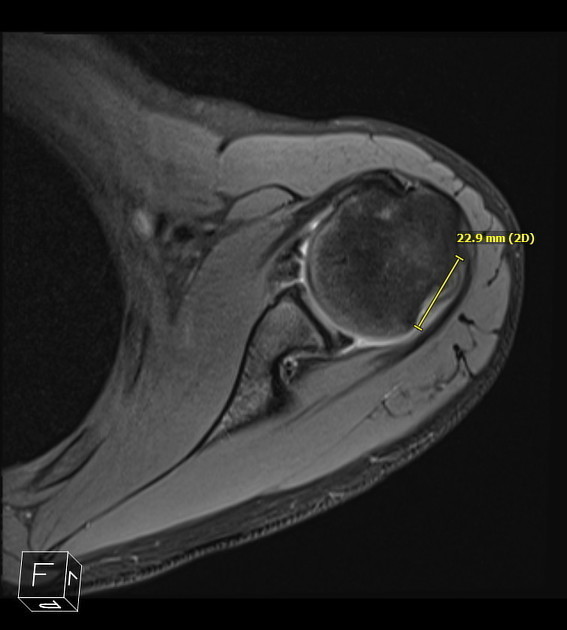Bipolar shoulder lesions of anterior glenohumeral dislocations (i.e. combined bony Bankart lesions and Hill-Sachs defects) put patients at increased risk of Hill-Sachs engagement or recurrent instability. Determining if the Hill-Sachs defects are on-track or off-track can help guide management, although arthroscopy remains gold-standard for diagnosis.
On this page:
Images:
Pathology
The glenoid track refers to the area of contact between the humeral head and glenoid and is defined as ~83% of glenoid width 2,3. A Hill-Sachs defect that is smaller than the track ("on-track") will maintain contact and is at a lower risk of engagement and instability. Conversely, a Hill-Sachs defect that is larger than the glenoid track ("off-track") will be at increased risk of engagement and instability (i.e. is an "engaging Hill-Sachs defect") 3.
Thus, two factors contribute to determining if a bipolar bone lesion is on-track or off-track:
anteroinferior glenoid bone loss
Hill-Sachs interval
Off-track lesions can result from either a large bony Bankart lesion or Hill-Sachs defect, or a combination of a moderate-sized Hill-Sachs defect and a moderate-sized bony Bankart lesion.
Radiographic features
Determining on-track or off-track lesions was initially described on CT but can also be calculated on MRI 2. Two measurements are required 2,3:
-
glenoid track: calculated on a sagittal oblique plane of the glenoid using the best-fit circle method
a best-fit circle is placed on the glenoid, matching the posterior and inferior borders
a horizontal line is drawn through the center of the best-fit circle reaching both anterior and posterior aspects (D)
a second horizontal line is drawn along the same plane from the anterior aspect of the circle to the anterior glenoid (d), i.e. measuring the width of anterior glenoid bone loss
glenoid track = (0.83 x D) - d
-
Hill-Sachs interval = Hill-Sachs defect + bone bridge between the rotator cuff attachment and lateral margin of the Hill-Sachs defect
measured in the axial plane
A bipolar lesion is said to be engaging if the Hill-Sachs interval is larger than the glenoid track:
non-engaging, on-track Hills-Sachs defect = Hill-Sachs interval < glenoid track
engaging, off-track Hills-Sachs defect = Hill-Sachs interval > glenoid track
Treatment and prognosis
Off-track bipolar lesions may be treated surgically with reconstitution of the anteroinferior glenoid bone stock (commonly via a Latarjet procedure) +/- remplissage depending on the size of the Hill-Sachs defect 3.







 Unable to process the form. Check for errors and try again.
Unable to process the form. Check for errors and try again.